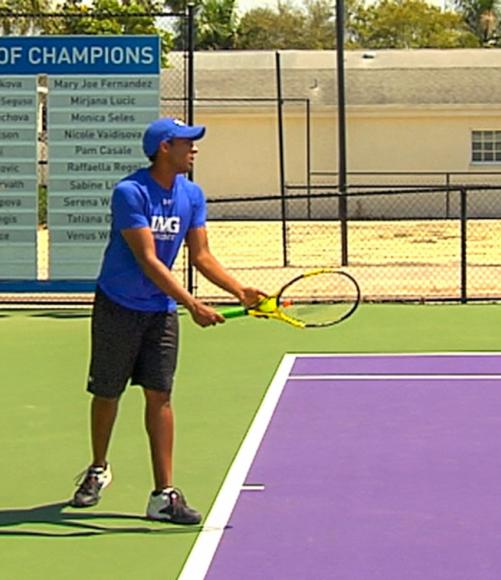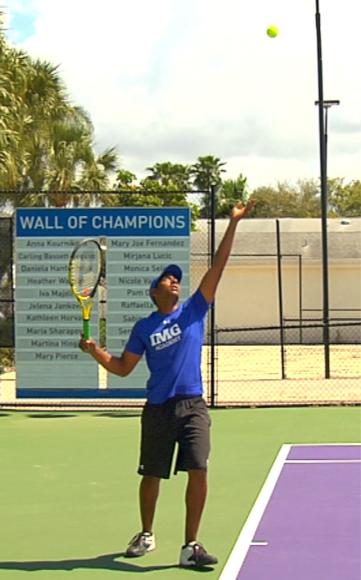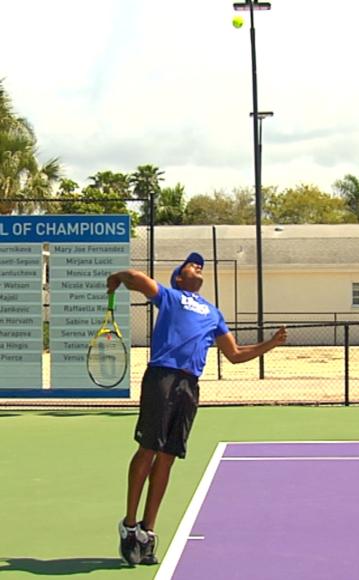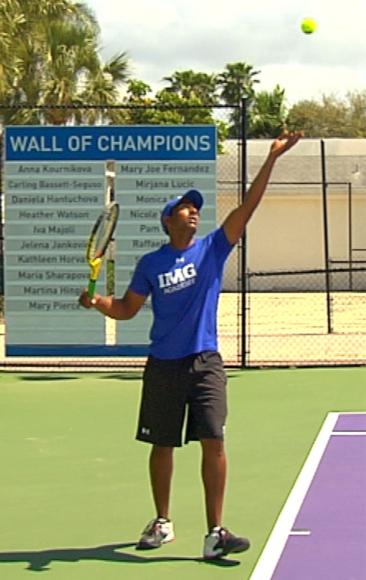Types of Serves
This is an excerpt from Nick Bollettieri’s Tennis Handbook 2nd Edition With HKPropel Online Video by Nick Bollettieri.
For many years only one technique was taught for the serve. Set your feet shoulder-width apart, point your front foot toward the target, put your racket hand and ball-tossing hand in front of you at waist height, start with your racket hand and ball-tossing hand going down together and up together, and do not move your back foot until you make contact with the ball and step into the court. Wow, times have changed.
There are still classic service motions such as those used by Roger Federer and Pete Sampras, but many others used today are just as effective. There is the half motion where the racket does not go down but starts immediately upward, and there's also the abbreviated motion where the racket is set above the shoulder before the toss is made.
Nick's Tip
No matter what motion you have, when you have certain elements correct, you will have an effective serve. If they work, don't change them.
Elements of the Aggressive Serve
An aggressive serve can have different variations and if delivered properly will provide the server with an outright winner, an error by the returner, or a defensive reply by the returner. Here are the important elements of the aggressive serve.
Grip
It is acceptable for very young and basic beginners to learn to serve with the forehand grip they have become comfortable with. We make this exception in order to ensure that young players experience more success in the beginning. As they begin to progress and become open to adjustments to improve, it's time to introduce them to serving in a full continental grip. It is an essential fundamental to serving at higher levels of play.
Starting Position
Most players start with the ball and racket together. For the stance, the feet are approximately shoulder-width apart, preferably with the front foot pointed toward the net post. It is quite common for the pros to start with their body weight forward in the stance for the start position, then shift the weight to the back foot as they start the motion, then shift forward to toss and hit. It's all a matter of what you feel comfortable with. Coaches should look at the student's natural style and then determine what will be the best for him. See figure 5.5 for an example of a correct starting position for the serve.

Starting position for a serve.
Take-Back
There are several predominant styles of take-back. There's over the shoulder, used by Andy Roddick and Venus Williams. Then you have the classic Federer pendulum down swing that takes the racket up into position. There are other abbreviated take-backs as well. Regardless of which style you prefer, what's most important is that the hitting arm and racket are positioned properly and on time in the set-to-launch position. The take-back should be in sync with the timing of the toss action to ensure consistent toss - hit rhythm on the serve. See figure 5.6 for an example of a correct take-back for the serve.


Take-back for a serve.
Toss Action
To be precise with the toss, most pros keep the toss arm fully extended throughout the toss motion. The ball is released from the hand at approximately eye level. The toss arm continues upward until the palm of the toss hand faces toward the sky. As the toss arm starts going up, the body weight is shifting forward in the stance for the release of the ball to produce a straighter up and down ball path. The height of the toss varies based on the serve, but the ball should reach a height at least 12 inches (30 cm) higher than the top of the racket at contact. Players vary the ball position for the various types of serves, but as a general rule, you want your toss to remain inside the baseline and to the hitting-arm side of the body. See figure 5.7, a and b, for an example of a correct tossing action for the serve.

Tossing action for a serve.
Set to Launch: Platform and Pinpoint Stance
The platform stance describes the technique of those players who maintain the same starting stance throughout the motion. Platform servers such as Federer and Djokovic shift their weight forward for the set-to-launch position. As they bend their knees, the hips shift forward toward the toes of both feet as the chest angles upward toward the contact point. This chest angle aimed at the contact point is a crucial fundamental for developing a powerful and healthy serve motion. The shoulders tilt as the chest aims upward so that the tilted shoulders and arms establish a straight line with the contact point. The heels of the feet are elevated, indicating the weight is into the toes of both feet for the launch.
The pinpoint stance describes the technique of those players who bring the back foot forward to a position near the front foot for the set-to-launch. Many pros shift the front side of their hips forward over their toes to create a position similar to the look of a pole-vaulter's pole stretched back and bent into an arc shape. This stretched position enables the player to create an upward snap from the hip to launch the racket head up toward contact. With the body weight primarily on the front foot, the chest angle aims upward at the contact point, which is a crucial fundamental for developing a powerful and healthy serve motion. The shoulders tilt as the chest aims upward so that the shoulders and arms create a straight line with the contact point.
Learn more about Nick Bollettieri's Tennis Handbook, 2nd Ed.
More Excerpts From Nick Bollettieri’s Tennis Handbook 2nd Edition With HKPropel Online VideoSHOP

Get the latest insights with regular newsletters, plus periodic product information and special insider offers.
JOIN NOW


